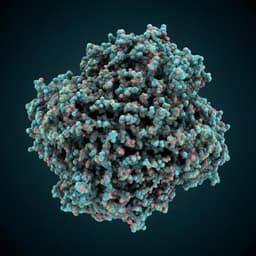
Chemistry
Quantum plasmonics pushes chiral sensing limit to single molecules: a paradigm for chiral biodetections
C. Zhang, H. Hu, et al.
Discover groundbreaking advancements in chiral sensing of single molecules. This research, conducted by Chi Zhang, Huatian Hu, Chunmiao Ma, Yawen Li, Xujie Wang, Dongyao Li, Artur Movsesyan, Zhiming Wang, Alexander Govorov, and Quan Gan, unveils a tunable chiral supramolecular plasmonic system that surpasses existing technologies. With the ability to detect enantiomeric excess at the single-molecule level, the potential for biomedical applications is immense.
~3 min • Beginner • English
Introduction
Chiral molecule sensing is crucial for pharmaceutical and biomedical applications, yet single-molecule chiroptical detection remains elusive with traditional single-molecule techniques such as Raman, fluorescence, and nanopore sensing, which poorly discriminate enantiomers. Advances in nanophotonics, leveraging superchiral fields and plasmon-coupled circular dichroism (PCCD) characterized via single-particle circular differential scattering (CDS), have improved sensitivity down to a few biomolecules. However, limited control over gap size and molecular orientation in conventional plasmonic constructs constrains CDS enhancement, keeping the detection limit above single-molecule levels. Au nanoparticle-on-mirror (NPOM) nanocavities with sub-nm gaps provide extreme local electric-field enhancement and out-of-plane dipoles, offering a promising platform for single chiral molecules. While quantum tunnelling in sub-nm gaps typically diminishes local fields, its effect on optical chirality has been ambiguous. The study aims to design and validate a tunable chiral supramolecular NPOM system operating across classical and quantum regimes to push chiral sensing sensitivity toward single molecules and to elucidate the role of tunnelling-induced interactions in chiroptical enhancement.
Literature Review
Previous single-molecule techniques (single-molecule Raman, fluorescence, nanopore sensing) lack robust enantiomer discrimination. Nanophotonic strategies using superchiral fields and plasmon-coupled circular dichroism (PCCD) with single-particle CDS have significantly improved sensitivity to a few biomolecules via synergistic enhancement mechanisms. Nevertheless, insufficient control of gap dimensions and molecular orientation has limited CDS enhancement. Prior chiroptical platforms include nanoparticles, dimers/nanorods and chains, nanocuvettes, and patterned chiral metasurfaces (e.g., shurikens, gammadia), with varying mode volumes, detection limits, and g-factors. NPOM nanocavities are known for high local field enhancements (up to ~1000) and have enabled single-molecule strong coupling and quantum plasmonics; however, quantum tunnelling was commonly assumed detrimental to plasmonic enhancement. The full impact of tunnelling on optical chirality in such nanogaps remained unclear, motivating the present investigation.
Methodology
Design and materials: Helical oligoamide sequences (OS), comprising quinoline-based octamers with stereogenic centers, were synthesized and characterized (Supplementary Figs. 1–30). These fold into P or M single helices and duplex into enantiomeric double helices (DHs) via π–π interactions, exhibiting distinct UV absorption and CD. Racemic mixtures show no CD in ensemble.
NPOM fabrication: A self-assembled monolayer (SAM) of OS DHs was formed on Au films (70 nm) by immersing in OS-1 (10 mM) chloroform for 12 h, rinsed, then Au nanoparticles (varied sizes) were drop-cast for 20 min and dried. The SAM spacer thickness was <~2 nm. For gap reduction, samples were immersed in hot chloroform (60 °C, 10 min) to dissociate DHs into single helices (SHs), shrinking the gap. Samples were vacuum-dried before spectroscopy.
Optical measurements: Dark-field (DF) scattering spectra and CDS were recorded on a customized DF microscope (100×, NA=0.9; spectrometer QEPro). LCP and RCP incidence were generated via linear polarizer and quarter-wave plate (±45°). Asymmetric incidence was used for optimal SNR. CDS spectra were computed as CDS% = 2(S_LCP − S_RCP)/(S_LCP + S_RCP) × 100%, equivalent to the g-factor. Over 30–50 single NPOMs were measured for statistics. Optical chirality C/C0 maps were computed; superchiral fields increased with decreasing gap size, including in quantum regime.
Packing density and morphology: SAM packing density (~0.2 nm^2 per DH) was measured by quartz crystal microbalance; SEM imaged NPOM morphology. Facet sizes (for ~80 nm NPs) were ~5–10 nm; estimated DH counts per facet were ~4–16 depending on facet size.
Numerical simulations: Finite element method (FEM) simulated near fields, scattering, and CDS for NPOMs of different NP sizes and gap thicknesses. Circularly polarized oblique incidence (64°, ~0.9 NA) was used. Au permittivity followed Johnson–Christy. Chiral medium used constitutive relations D = ε0εE − iκH, B = μ0μH + iκE, with Lorentzian-fitted ε and κ from experimental spectra. For thin-film chirality, analytical expressions were fitted to extract κ parameters. To ensure computational efficiency, κ was scaled by 2.5×10^7 and results normalized.
CDS enhancement (CDSE): Defined as CDSE = CDS_NPOM+OS / |CDS_OS|, where CDS_OS is the intrinsic molecular CDS from a volume matching the NPOM mode.
Quantum-corrected model (QCM): For sub-nm gaps, the gap permittivity was phenomenologically modified to include tunnelling, enabling simulation from classical regime (CR) to quantum regime (QR). The tunnelling junction was approximated as a small disk with cross-section ~facet area and height equal to OS thickness. Scattering evolution and CDS were simulated across gap sizes.
Mode volume: Estimated via Purcell relation using a dipole at the gap hotspot; NPOM mode volume ~37 nm^3.
Controls and orientation: CDS from NPOMs with achiral molecules (1,4-benzenedithiol) was negligible, confirming molecular origin of PCCD. Molecular dipole orientation relative to plasmonic dipole was considered; alignment can boost CDSE up to ~3-fold.
Key Findings
- Strong chiroptical response from racemic OS in NPOM gaps: despite racemates being achiral in ensemble, NPOMs resolve local enantiomeric excess due to small molecule counts per gap, producing diverse CDS with both signs or near-zero signals. Approximately 47% of NPOMs showed |CDS| ~20%, while ~42% showed negligible CDS, matching statistical ee for ~10 DHs per gap.
- Robust single-particle CDS: Over 50 NPOMs with P- or M-helices exhibited typical CDS intensities around −20% (P-helix) and +20% (M-helix). Variations arise from NP size/shape, molecule count, and substrate effects.
- Size-dependent plasmonic response: Increasing NP size redshifts scattering and the CDS peak/valley wavelengths, with comparable CDS magnitudes across sizes. FEM simulations agree with experiments.
- Field and optical chirality: NPOMs create superchiral fields with C/|C0| up to ~50; local electric-field enhancement up to ~300; mode volume ~37 nm^3.
- Few-molecule sensitivity: SAM packing density (~0.2 nm^2 per DH) and facet sizes (5–10 nm) imply ~4–16 DHs per gap; using ~80 nm NPOMs yields detectable contributions of ~2% CDS per DH. A minimum of four molecules per single Au particle was detected, enabling detection of enantiomeric excess within a monolayer.
- Classical-to-quantum transition: As gaps shrink, plasmon resonances first redshift then blueshift due to tunnelling. CDS magnitude increases with decreasing gap in the classical regime, decreases near the transition (~0.7 nm) due to reduced local E-field from tunnelling, then increases again in the quantum regime.
- Mechanistic insight: Enhanced CDS in the quantum regime is attributed to additional Coulomb interactions between chiral supramolecules and tunnelling electrons, contributing an extra absorption term Q = ∫ J·E dV, which compensates for reduced local fields and boosts CDSE below ~0.7 nm.
- Simulations corroborate experiments: QCM reproduces scattering evolution and CDS trends from CR to QR; orientation alignment can further enhance CDSE by ~3×.
Discussion
The study demonstrates that NPOM nanocavities functionalized with helical oligoamide supramolecules provide a powerful chiroptical sensing platform capable of detecting very few chiral molecules and resolving local enantiomeric excess within nominally racemic monolayers. By systematically tuning the nanogap from classical to quantum regimes, the work clarifies that although quantum tunnelling reduces local electric fields at the transition, it does not universally suppress chiroptical response. Instead, in sub-nm gaps, strong Coulomb interactions between tunnelling electrons and chiral molecules introduce an additional absorption pathway that enhances CDS, overturning the conventional assumption that tunnelling is purely detrimental in plasmonic sensing. The NPOM’s extreme mode confinement, out-of-plane dipolar field, and strong PCCD coupling, together with superchiral fields, enable large g-factors and sensitivity approaching single-molecule levels. These findings advance the understanding of light–chiral-matter interactions across scales and suggest general design principles for next-generation chiral biosensors with superior enantiomer discrimination and biomedical utility.
Conclusion
This work introduces a tunable chiral supramolecular NPOM system that operates across classical and quantum plasmonic regimes to push chiral sensing toward single-molecule sensitivity. Key contributions include: (1) experimental and theoretical elucidation of tunnelling-induced chiroptical enhancement via Coulomb interactions in sub-nm gaps; (2) robust single-particle CDS with large g-factors and superchiral fields; (3) capability to detect as few as four molecules per Au particle and to resolve local enantiomeric excess within racemates; and (4) clear design and fabrication protocols for reproducible NPOM-based chiral sensors. Future research can focus on precise control of gap geometry and molecular orientation, integration with microfluidics for in situ sensing, extending to diverse chiral analytes (small-molecule drugs, peptides), and leveraging real-time quantum plasmonic modulation to further boost sensitivity and selectivity.
Limitations
- Variability in CDS magnitude arises from NP size/shape heterogeneity, variable molecule counts per gap, and substrate effects, leading to device-to-device variability.
- CDS measurements relied on asymmetric illumination to maximize signal; symmetric incidence yielded much weaker signals, which may limit universal applicability or require careful optical alignment.
- Molecular orientation in the gap is not fully controlled; although alignment can enhance CDSE by ~3×, incomplete control may limit optimal performance.
- Simulations used an artificially magnified chirality parameter for numerical stability and a phenomenological QCM; while trends and lineshapes are preserved, absolute values may carry model-dependent uncertainty.
- The exact gap size at the classical–quantum transition (~0.7 nm) and tunnelling junction morphology are inferred from models and ensemble statistics rather than direct atomic-scale measurements.
Related Publications
Explore these studies to deepen your understanding of the subject.







